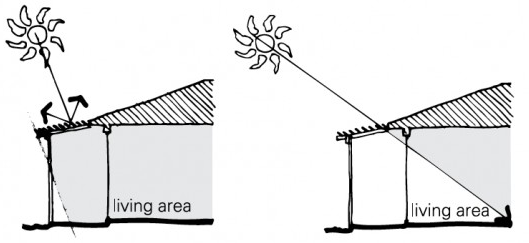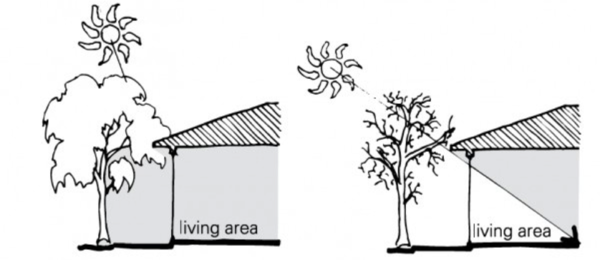Shading technology: Difference between revisions
J.williams (talk | contribs) No edit summary |
J.williams (talk | contribs) m (1 revision imported) |
(No difference)
| |
Revision as of 21:31, 26 August 2015

Shading technology is a broad term that describes additions to a building that prevent over-heating or cooling of the space. These additions include, awnings, blinds, deciduous trees and roof overhangs.[2] Shading a very old (but still underutilized) form passive solar heating and cooling.
Figure 1 shows both the summer and winter sun. The overhang is long enough to shade the sun during summer but short enough to allow sunlight in during winter. This keeps sunlight out during summer, keeping the internal living space cool. The opposite is true in the other half of the year. The overhang allows solar radiation to enter the building, warming up the internal living space.

The left half of figure 2 represents summer and the right represents winter. The ended roof or overhang has an awning attached. The awning has eves at an angle that prevent excessive amounts of solar radiation from entering the building, keeping the internal living space cool. The opposite is true in the other half of the image. The eves are slanted to allows adequate amounts of solar radiation to enter the building, warming up the internal living space.

The left half of figure 3 represents summer and the right represents winter. The ended roof or overhang, as well as the leafy tree prevent excessive amounts of solar radiation from entering the building, keeping the internal living space cool. The opposite is true in the other half of the image. A bare tree allows adequate amounts of solar radiation to enter the building, warming up the internal living space.
References
- ↑ http://architecturerevived.blogspot.ca/2013/10/designing-passive-solar-heating-and.html
- ↑ W. Feist. “First Steps: What Can be a Passive House in Your Region with Your Climate?” Internet: http://passive.bg/files/files/83dede941ff2a5e60dd8e0d1cbfc24acFirstStep.pdf, [Sept. 19, 2013]
- ↑ 3.0 3.1 Sustainable Melbourne. “Australia’s Premier Handbook On Sustainable Homes Design.” Internet: http://www.sustainablemelbourne.com/visions/australias-premier-handbook-on-sustainable-homes-design/, [Oct. 14, 2013]

